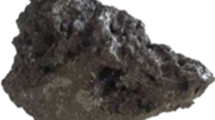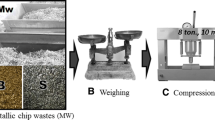Abstract
The textile industry stands out as one of the largest consumers of water among the industrial sectors. Additionally, its effluent presents characteristics such as high load of chemical oxygen demand (COD), total organic carbon (TOC), suspended solids, color, turbidity, phenol, and salts, which require an efficient treatment of the wastewater produced. Among the several researches that have arisen focused on the treatment of textile effluents, electrocoagulation stands out. This method consists of an electrochemical process that generates its own coagulant by applying electric current to metal electrodes immersed in the solution. The electrodes used in the present study are metallic plates made of scrap iron. The objective of this work is to evaluate their application in an electrocoagulation process for the decolorization of real and synthetic effluents. The efficiency of the treatment was evaluated by applying it to a synthetic effluent containing commercial indigo blue dye and to a real effluent from the textile industry, assessing parameters such as color, turbidity, pH, electrical conductivity, COD, TOC, phenol, soluble iron, sludge generation, and electrode wear. The synthetic effluent obtained average color removal of 95%, 96% phenol, and low sludge production in 120 min of electrolysis. In the real effluent from the textile industry, an average color removal of 92%, 97% turbidity, 100% phenol, 65% TOC, and 49% COD in 90 min of electrolysis was obtained. The electrocoagulation process using scrap iron as electrodes proved to be efficient in removing the dye present in the real textile industry effluent, as well as in the synthetic effluent.













Similar content being viewed by others
Data Availability
All data generated or analyzed during this study are included in this published article (and its supplementary information files).
References
Abu Ghalwa, N. M., Saqer, A. M., & Farhat, N. B. (2016). Removal of reactive red 24 dye by clean electrocoagulation process using iron and aluminum electro. The Journal of Chemical Engineering & Process Technology, 7, 1–7. https://doi.org/10.4172/2157-7048.1000269
Akhtar, A., Aslam, Z., Asghar, A., et al. (2020). Electrocoagulation of Congo red dye-containing wastewater: Optimization of operational parameters and process mechanism. Journal of Environmental Chemical Engineering, 8, 104055. https://doi.org/10.1016/j.jece.2020.104055
Albuquerque, L. F., Salgueiro, A. A., Melo, J. L. D. S., & Chiavone-Filho, O. (2013). Coagulation of indigo blue present in dyeing wastewater using a residual bittern. Separation and Purification Technology, 104, 246–249. https://doi.org/10.1016/j.seppur.2012.12.005
APHA, Awwa, WEF,. (2005). Standard methods for the examination of water and wastewater. Amer Public Health Assn.
Bener, S., Bulca, Ö., Palas, B., et al. (2019). Electrocoagulation process for the treatment of real textile wastewater: Effect of operative conditions on the organic carbon removal and kinetic study. Process Safety and Environment Protection, 129, 47–54. https://doi.org/10.1016/j.psep.2019.06.010
Brillas, E., & Martínez-Huitle, C. A. (2015). Decontamination of wastewaters containing synthetic organic dyes by electrochemical methods. An updated review. Applied Catalysis B: Environmental, 166–167, 603–643.
Carmelio, J. (2018). Guia ABIFA de Fundição. Associação Brasileira de Fundição, São Paulo
Carmen, Z., Daniel, S. (2012). Textile organic dyes – Characteristics, polluting effects and separation/elimination procedures from industrial effluents – A critical overview. In: Organic pollutants ten years after the stockholm convention - Environmental and analytical update. InTech
Conama. (2005). Resolução CONAMA n° 430/2011. http://www2.mma.gov.br/port/conama/legiabre.cfm?codlegi=646. Accessed 23 Jan 2018
Daneshvar, N., Ashassi Sorkhabi, H., & Kasiri, M. B. (2004). Decolorization of dye solution containing acid red 14 by electrocoagulation with a comparative investigation of different electrode connections. Journal of Hazardous Materials, 112, 55–62. https://doi.org/10.1016/j.jhazmat.2004.03.021
de Neto, S., & A, Magri TC, Silva GM, Andrade AR,. (2011). Tratamento de resíduos de corante por eletrofloculação: Um experimento para cursos de graduação em QuímicaTratamento de resíduos de corante por eletrofloculação: Um experimento para cursos de graduação em Química. Quimica Nova, 34, 1468–1471.
Emamjomeh, M. M., & Sivakumar, M. (2009). Review of pollutants removed by electrocoagulation and electrocoagulation/flotation processes. Journal of Environmental Management, 90, 1663–1679.
Garcia-Segura, S., Eiband, M. M. S. G., de Melo, J. V., & Martínez-Huitle, C. A. (2017). Electrocoagulation and advanced electrocoagulation processes: A general review about the fundamentals, emerging applications and its association with other technologies. Journal of Electroanalytical Chemistry, 801, 267–299.
Ghaly, A. E., Ananthashankar, R., Alhattab, M., et al. (2014). Production, characterization and treatment of textile effluents: A critical review. The Journal of Chemical Engineering & Process Technology, 5, 1–18. https://doi.org/10.4172/2157-7048.1000182
GilPavas, E., Dobrosz-Gómez, I., & Gómez-García, M. Á. (2017). Coagulation-flocculation sequential with Fenton or Photo-Fenton processes as an alternative for the industrial textile wastewater treatment. Journal of Environmental Management, 191, 189–197. https://doi.org/10.1016/j.jenvman.2017.01.015
Hendaoui, K., Trabelsi-Ayadi, M., & Ayari, F. (2021). Optimization and mechanisms analysis of indigo dye removal using continuous electrocoagulation. Chinese Journal of Chemical Engineering, 29, 242–252. https://doi.org/10.1016/j.cjche.2020.07.065
Kobya, M., & Demirbas, E. (2015). Evaluations of operating parameters on treatment of can manufacturing wastewater by electrocoagulation. Journal of Water Process Engineering, 8, 64–74. https://doi.org/10.1016/j.jwpe.2015.09.006
Kobya, M., Gengec, E., & Demirbas, E. (2016). Operating parameters and costs assessments of a real dyehouse wastewater effluent treated by a continuous electrocoagulation process. Chemical Engineering and Processing: Process Intensification, 101, 87–100. https://doi.org/10.1016/j.cep.2015.11.012
Núñez, J., Yeber, M., Cisternas, N., et al. (2019). Application of electrocoagulation for the efficient pollutants removal to reuse the treated wastewater in the dyeing process of the textile industry. Journal of Hazardous Materials, 371, 705–711. https://doi.org/10.1016/j.jhazmat.2019.03.030
Patel, H., Vashi, R. T. (2015). Characterization of textile wastewater. In: Patel, H., Vashi, R. T. (eds) Characterization and Treatment of Textile Wastewater. Elsevier, pp 21–71
Savin, I.-I., & Butnaru, R. (2008). Wastewater characteristic in textile finishing mill. Environmental Engineering and Management Journal, 7, 859–864.
Singh, K., & Arora, S. (2011). Removal of synthetic textile dyes from wastewaters: A critical review on present treatment technologies. Critical Reviews in Environment Science and Technology, 41, 807–878. https://doi.org/10.1080/10643380903218376
Sirirerkratana, K., Kemacheevakul, P., & Chuangchote, S. (2019). Color removal from wastewater by photocatalytic process using titanium dioxide-coated glass, ceramic tile, and stainless steel sheets. Journal of Cleaner Production, 215, 123–130. https://doi.org/10.1016/j.jclepro.2019.01.037
Su, C. C., Pukdee-Asa, M., Ratanatamskul, C., & Lu, M. C. (2011). Effect of operating parameters on decolorization and COD removal of three reactive dyes by Fenton’s reagent using fluidized-bed reactor. Desalination, 278, 211–218. https://doi.org/10.1016/j.desal.2011.05.022
Syafalni, S., Abustan, I., Dahlan, I., et al. (2012). Treatment of dye wastewater using granular activated carbon and zeolite filter. Modern Applied Science, 6, 37–51. https://doi.org/10.5539/mas.v6n2p37
Tak, B., yul, Tak B sik, Kim Y ju, et al. (2015). Optimization of color and COD removal from livestock wastewater by electrocoagulation process: Application of Box-Behnken design (BBD). Journal of Industrial and Engineering Chemistry, 28, 307–315. https://doi.org/10.1016/j.jiec.2015.03.008
Thakur, C., Srivastava, V. C., & Mall, I. D. (2009). Electrochemical treatment of a distillery wastewater: Parametric and residue disposal study. Chemical Engineering Journal, 148, 496–505. https://doi.org/10.1016/j.cej.2008.09.043
Torres, N. H., Souza, B. S., Ferreira, L. F. R., et al. (2019). Real textile effluents treatment using coagulation/flocculation followed by electrochemical oxidation process and ecotoxicological assessment. Chemosphere, 236, 124309. https://doi.org/10.1016/j.chemosphere.2019.07.040
Verma, A. K. (2017). Treatment of textile wastewaters by electrocoagulation employing Fe-Al composite electrode. Journal of Water Process Engineering, 20, 168–172. https://doi.org/10.1016/j.jwpe.2017.11.001
Volkov, V. V., Chelli, R., Righini, R., & Perry, C. C. (2020). Indigo chromophores and pigments: Structure and dynamics. Dyes and Pigments, 172, 107761. https://doi.org/10.1016/j.dyepig.2019.107761
Ya, V., Le, G. E., Chen, Y. M., et al. (2018). Scrap iron packed in a Ti mesh cage as a sacrificial anode for electrochemical Cr(VI) reduction to treat electroplating wastewater. Journal of the Taiwan Institute of Chemical Engineers, 87, 91–97. https://doi.org/10.1016/j.jtice.2018.03.016
Yaseen, D. A., & Scholz, M. (2019). Textile dye wastewater characteristics and constituents of synthetic effluents: A critical review. International Journal of Environmental Science and Technology, 16, 1193–1226.
Zazou, H., Afanga, H., Akhouairi, S., et al. (2019). Treatment of textile industry wastewater by electrocoagulation coupled with electrochemical advanced oxidation process. Journal of Water Process Engineering, 28, 214–221. https://doi.org/10.1016/j.jwpe.2019.02.006
Acknowledgements
The authors gratefully acknowledge the Rio Grande do Sul State Research Support Foundation (FAPERGS) for the financial support (scientific initiation scholarship grant no. 194/UFFS/2019) and the Federal University of Fronteira Sul was responsible for the laboratory area and the acquisition of reagents and equipment, (no. 459/ UFFS /2019).
Author information
Authors and Affiliations
Contributions
All authors contributed to the study conception and design. Material preparation, data collection, and analysis were performed by RDM, LB, VCdL, AD, CDR, and GDLP. The first draft of the manuscript was written by RDM, VCdL, and GDLP and all authors commented on previous versions of the manuscript. All authors read and approved the final manuscript.
Corresponding author
Ethics declarations
Ethics Approval and Consent to Participate
Not applicable.
Consent for Publication
Not applicable.
Competing Interests
The authors declare no competing interests.
Additional information
Publisher's Note
Springer Nature remains neutral with regard to jurisdictional claims in published maps and institutional affiliations.
Supplementary Information
Below is the link to the electronic supplementary material.
Rights and permissions
About this article
Cite this article
De Maman, R., Behling, L., da Luz, V.C. et al. Oxidation of Textile Dye Through Electrocoagulation Process Using Scrap Iron Electrodes. Water Air Soil Pollut 233, 90 (2022). https://doi.org/10.1007/s11270-022-05564-2
Received:
Accepted:
Published:
DOI: https://doi.org/10.1007/s11270-022-05564-2




